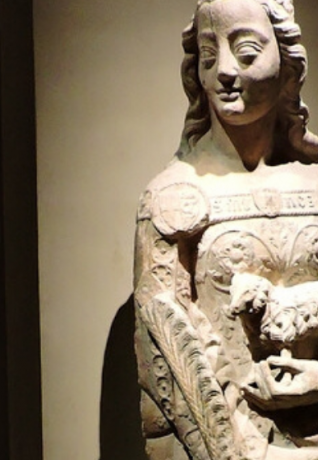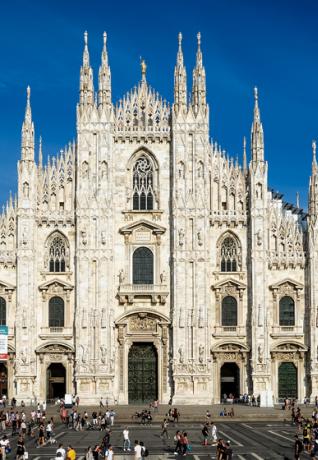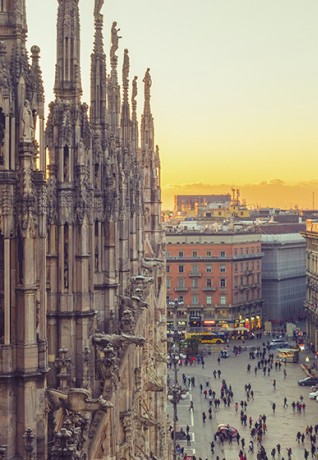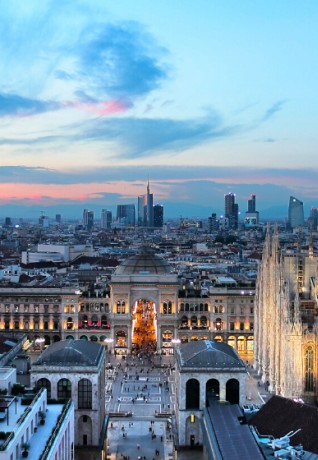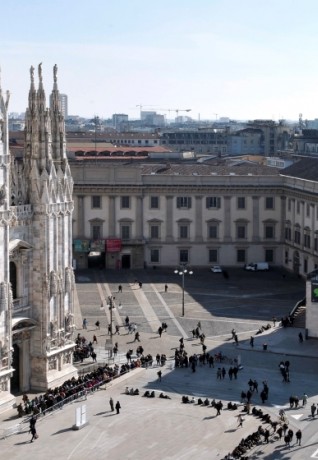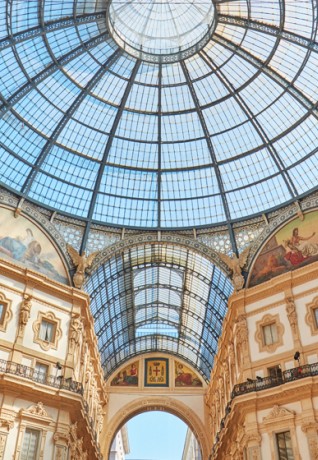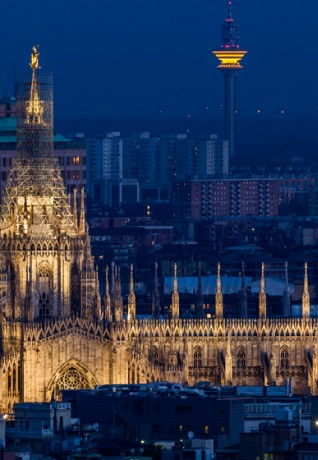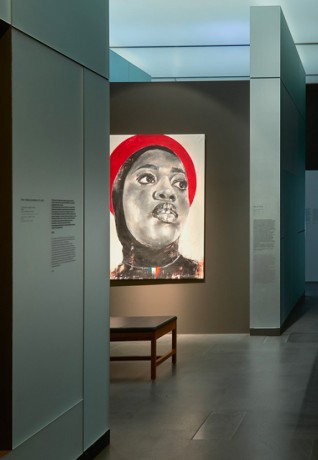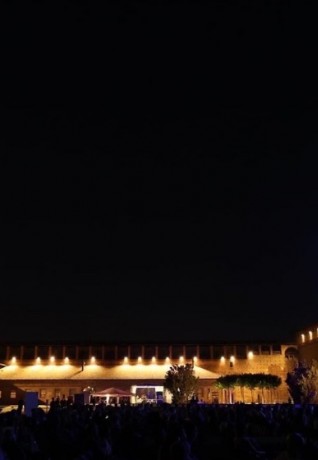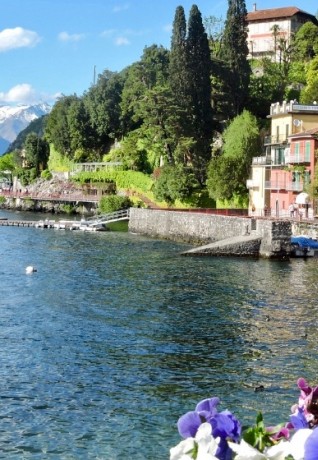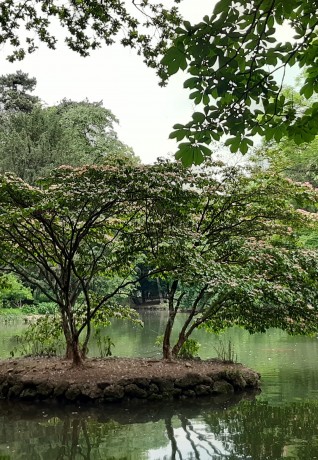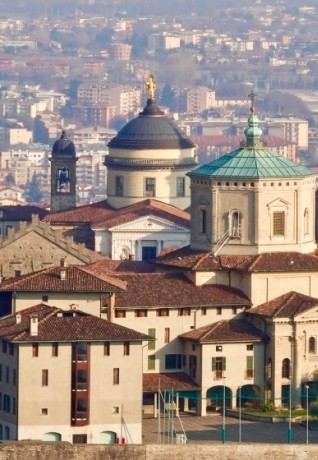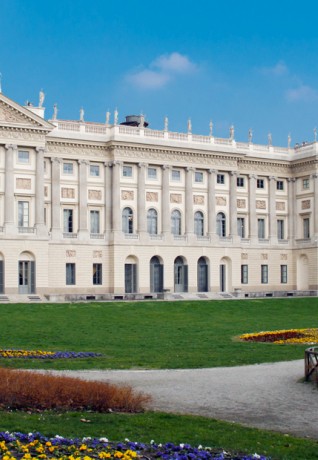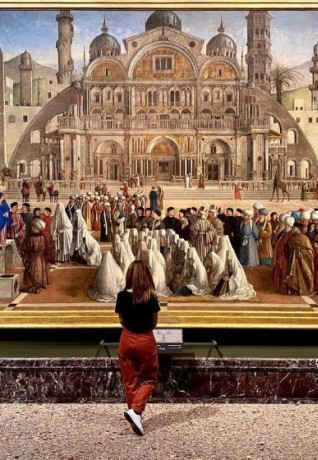10 + 1 amazing things to look out for in the Milano Duomo

- 1. The Statue of Liberty was created in Milano
- 2. A dragon sleeping on the Duomo’s façade
- 3. Look for your zodiac sign on the floor of the Duomo
- 4. Spot the statues that were already erected before the discovery of America
- 5. One of the nails from Christ’s crucifixion is preserved in the Duomo
- 6. A horror story from the past: St. Bartholomew flayed
- 7. Technicolour cinema and saffron in the stained glass windows
- 8. Madonna of the Roses... without any roses
- 9. The treasure hidden beneath the parvis
- 10. The only church in the world where you can walk over the entire rooftop
- 11. Ten plus 1. One extra for the undisputed symbol of Milano: the Madonnina
A visit to Milano’s Duomo is absolutely top of the to-do list for anyone arriving in the city. One of the largest cathedrals in the world, it has thousands of fascinating intricate details and awesome stories to captivate both first-time visitors and those returning to admire the cathedral time after time.
Reminder: you need to purchase a ticket to enter the Duomo. You can buy it online here.
Here are 10 + 1 great things not to be missed during your visit. Open your eyes, look up to the spires in awe and enjoy the unique experience.
Before entering the Duomo, take a moment to admire the magnificent exterior: the Gothic Cathedral is constructed in pink-hued white marble from the Candoglia quarry, dedicated to provide its building materials since it was first established at the end of the 14th century. The numberless statues are also carved in marble and we would like to single out a very special one above the central door, on the left side of the balcony: it looks the same as the Statue of Liberty in New York.
La Legge Nuova (The New Law), crafted by the neoclassical sculptor Camillo Pacetti in 1810, is said to have been the source of inspiration for Frédéric Auguste Bartholdi’s famous Statue of Liberty.
As a Milanese saying goes: "If something can’t be found in Milano, then it doesn't exist"!
Still facing the Duomo’s central doorway, move slightly to the right hand side to admire the marble sculptures decorating the doorframe. On the right, just above eye level, you will see one of the mythological creatures that are a part of the city’s history: the dragon Tarantasio. Perhaps this bas-relief will rather make you think of a dinosaur but, whatever the case, the story behind it is fascinating.
Popular folklore narrates that a dragon, Tarantasio, haunted a marshy swamp in the Lodi area (apparently Lombardy’s very own Loch Ness monster…). It feasted on children and caused death and destruction throughout the area. Its breath was a horrific miasma. Umberto, founder of the Visconti family (future Dukes of Milano), stepped forward to slay the monster - and he eventually succeeded.
In memory of his brave undertaking, the biscione (dragon) with a baby in its mouth became the family emblem. The biscione can be seen all around the city, on ancient buildings, on the public drinking fountains and incorporated into the Inter Milan football club and Alfa Romeo’s logos.
And, of course, among the statues of the Duomo, stone witnesses of our city’s history.
Close to the main entrance of the Cathedral, you will notice a horizontal brass rod crossing the entire edifice from right to left. It is interspersed at regular intervals with marble tiles representing all the signs of the Zodiac. As you search for your sign consider the presence of this rarity: it is a sundial, the Duomo’s Solar Meridian.
If you observe the vault of the first chapel on the right, you will notice a small circular hole in the ceiling: a ray of sunlight enters at noon (solar time that varies 25 minutes compared to standard time) and, depending on the month, it shines on the relevant zodiac sign.
The sundial was placed by the astronomers from the Brera Astronomical Observatory in 1786 and is periodically modified, so that it continues to function in spite of the changes brought about by time, such as the lowering of the floor following the construction of the metro line that runs under the Duomo.
Construction on the Duomo began in 1386, starting from the apse; this means that the entire final framework of the cathedral was already in place before the discovery of America in 1492. As you look up at the statues on the capitals of the columns around the altar, it is fascinating to think that they already existed before Christopher Columbus sighted the coast of the new continent.
It is also remarkable to consider that the Duomo is the only church in the world with statues on the capitals of the pilasters. It anyway boasts a world record number of statues both within and on the exterior of a cathedral: a grand total of 3400!
And, since we are talking about numbers, take a look at these: the Duomo has 52 columns (like the weeks of the year), it is 158m long, has 164 large windows, 135 spires, 410 marble supports, 746 arch stones and weighs 325000 tons.
Standing in the central nave facing the altar, if you raise your eyes above the apse, you will notice a small red light in front of a large circular metal tabernacle. This is placed at a height of 40 meters and preserves the relic of the Sacred Nail, allegedly one of the nails from the cross of Christ’s crucifixion.
The precious relic is removed from the casket and brought down to the Cathedral’s altar once a year, in September, as part of one of the most evocative and unique ceremonies in Milanese ecclesiastical tradition: the ritual of the Nivola, in which a cloud-shaped "lift" ascends to the tabernacle to retrieve the nail. Check out the details here.
In the right transept, near the exit, you will notice a statue that could actually come out of a horror story from the past: the statue of St. Bartholomew flayed alive.
At first sight, it might seem that the saint has a cloak draped over his shoulders but it is actually a mantle of his own skin. According to tradition, Jesus’ disciple, St. Bartholomew, was flayed alive.
His skinned body, sculpted with meticulous attention to structural detail, depicts the muscles and blood vessels almost like an anatomical study, with fascinating and vaguely morbid realism.
This mesmerising statue aroused so much interest that it was moved from its original position on the exterior of the Duomo to a more appropriate place inside where it could be better admired. To this day, it remains a crowd-pleaser for tourists and Milanese alike.
The Duomo has 55 monumental windows; the earliest date as far back as the late 1300s, the most recent to the late 1900s. The best place to admire these masterworks is from the apse, where a cascade of light streaming through the three huge windows colours the floor of the aisle that circles the rear of the altar with its vibrant hues.
The two lateral windows represent stories from the Old and New Testaments, the central window represents the Apocalypse; they are impressive both in their size and in the quantity of figures. They are known as the "Bible of the Poor", since even those who could not read were in a condition to learn about the history of Christianity by observing the characters. As Bono, the lead vocalist from U2, once said: "Those Christian craftsmen invented cinema... light projected through colour to tell their story".
Legend has it that the Duomo’s stained glass windows provided inspiration for the Milanese risotto recipe: saffron, now an essential ingredient for the rice dish, was used to colour the yellow glass of the cathedral windows. Inspired by the vibrant colour, someone thought of using it to cook a risotto... and the rest is history!
Near the Duomo’s northern sacristy, you will be able to observe a painting with a special history. It is named the Madonna of the Roses but, bizarrely, there are no roses in the painting.
The name derives from a miracle that took place in the early fifteenth century. Having been besieged by the son of Bernabò Visconti, Lord of Milano, the city was now reduced to a state of famine: the troops decided to use the marble blocks set aside for the construction of the Duomo as projectiles for their catapults. Fearing that such sacrilege would bring misfortune to the city, a female churchgoer who often prayed before this image of the Virgin, laid a bouquet of roses in front of the Madonna in the hope of averting this peril.
She was unable to pray in the cathedral for several days: but when her son was injured in battle, she returned to the Madonna to pray for his salvation. As she was reciting the rosary, she realized that the old bouquet of roses, completely withered, now inexplicably bloomed in front in her eyes. Upon her return home, she found that her son had miraculously healed.
For this reason, the painting is still known today as Madonna delle Rose.
Before exiting you will notice a staircase near the counter-facade that descends below the Duomo: it leads to one of the cathedral’s secrets that was only discovered in the 1900s.
During excavations for the M1 red metro line that passes directly below ground, the engineers unearthed the remains of the ancient Baptistery of the Duomo under the parvis. Consequently, visitors can now access the lower floor level to visit the place where St. Augustine was baptized by St. Ambrose, then Bishop of Milano.
The original octagonal font is still preserved and the remains of the walls of the ancient Basilica that existed before the construction of the Duomo are still visible. A fascinating immersion into the Roman city as the Baptistery dates back to the 4th century.
Brain-teaser: why does the Baptistery have 8 sides? St. Ambrose himself issued the order to build the baptistery with 8 sides. Symbolically, he wanted to use numbers to indicate the passage from the Old to the New Testament; therefore, from life before Christ to the new Christian life. Indeed 7 is the traditional number of the Old Testament, while 7 +1, i.e. 8, indicates the new something "extra" brought by Jesus, represented by the addition of one side to the building.
Your visit should not end when you exit the Duomo: we suggest you go up to the rooftop terraces for an unforgettable experience.
251 steps to reach the first level or a quick ride in the elevator lead up to 8000 square metres of roof terraces, the largest walkable roof on a Gothic cathedral in the world.
A forest of spires to immerse yourself in: thousands of intricate details carved in marble open up before your eyes like a beautiful book to leaf through and admire as you gaze upwards.
We would like to draw your attention to two unusual details but keep your eyes peeled for other awesome gems. As you climb the staircase that leads from the first level to the top of the terraces look carefully at the decorations carved along the staircase towards the facade: you might be surprised to find that the ubiquitous occupants of the piazza, the pigeons, are immortalized here too.
Once you reach the top, check out the spires facing the piazza: on the left margin, you will see one representing two prize-fighters. Boxers on a cathedral, you might ask. Indeed: they were carved in memory of Primo Carnera, the great professional Italian boxer acclaimed worldwide.
Now, looking upwards, peek through the pinnacles and spires set on delicate flying buttresses to the breathtaking panorama: the mountains and skyscrapers on one side, the city on the other. The terraces are, in fact, one of the 10 must-see places from which to observe Milano from above.
Look up in awe at the Madonnina who observes you from above: the gleaming golden statue that stands in a privileged position 108.5 meters high and overlooks the Duomo.
There are many tales related to the city’s beloved patron: not everyone knows for instance that the halberd (a lance of Lombard origin) held in the Madonna’s right hand, acts as a lightning rod to protect the Duomo and the entire metropolis.
According to a law issued in the 1930s, no other city construction could exceed the Madonnina in height but when the Pirelli Skyscraper was built, the first high-rise in the city, this height was surpassed. Therefore, a new tradition began: when a building rises above 108.5 metres, a scaled down copy of the Madonnina is placed on its summit to ensure that the city’s patron always stands at the highest point. These days there are replicas on the roof of the Unicredit building and the Diritto skyscraper in the CityLife area, which have each passed the baton for being the tallest building in Milano.
Another interesting fact is that, on certain days of the year, the Italian flag is hoisted on the halberd to celebrate national holidays and anniversaries. The tradition initiated during the revolutionary Five Days of 1848 when two patriots raised the flag on the statue to signal the Austrian withdrawal from the city. The sight of the tricolore uplifted spirits in the city and roused a feeling of pride in the fighters of the barricades, spurring them on to victory. Click here for the flag hoisting schedule.

 Log in
Log in
